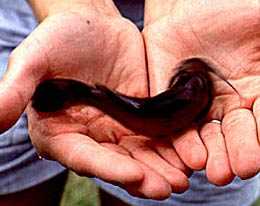Faunal analysis identifies the kinds of animal remains (bones, shells, antler) found at a site. From this information, archaeologists can tell the environment around the site, what the people ate, and where and sometimes how they obtained their food.
From the kinds of animals found, and sometimes from the age or size of the animals, they can decide during what seasons a site was occupied. For example, by looking at the pattern of tooth eruption in young deer, archaeologists can tell during what season a deer was killed. Deer are usually born in April. If a deer has the tooth eruption sequence typical of a 7-8 month old animal, then it was killed sometime around October or November.
The sizes of fish bones provide an indication of the size and age of the fish and can suggest what methods might have been used for taking the fish, such as netting, spearing, or using fishhooks.


Sometimes animal remains can be used as tools. Antlers were used in flintknapping for making stone tools, and the tines were made into projectile points. Shells were used for spoons and probably for other decorative purposes. Bones were made into pendants, ornaments, and perhaps basket handles.




